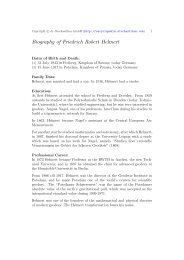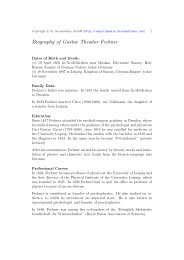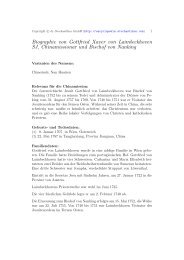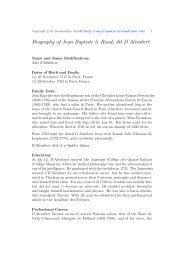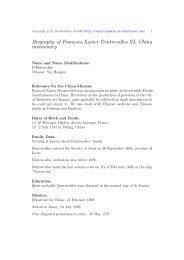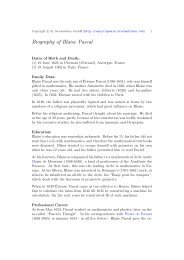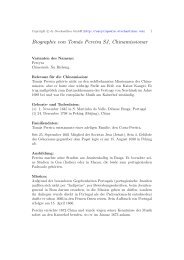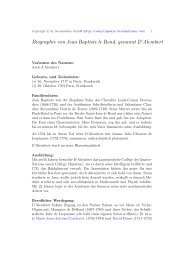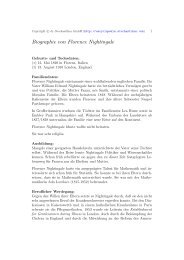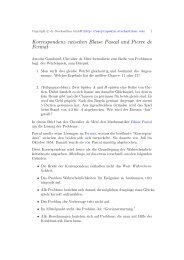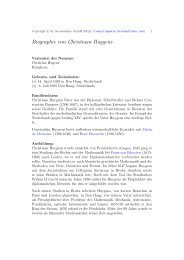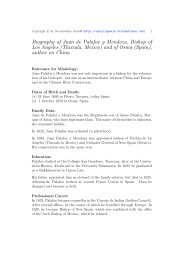Biography of Alvaro de Benavente OSA, China mis- sionary, Bishop ...
Biography of Alvaro de Benavente OSA, China mis- sionary, Bishop ...
Biography of Alvaro de Benavente OSA, China mis- sionary, Bishop ...
Create successful ePaper yourself
Turn your PDF publications into a flip-book with our unique Google optimized e-Paper software.
Copyright c○ by Stochastikon GmbH (http://encyclopedia.stochastikon.com) 3<br />
bear Tournon’s refutation <strong>of</strong> Confucianism and the <strong>de</strong>mand that all Chinese<br />
Christians and also the European <strong>mis</strong>sionaries had to be more obedient to<br />
a foreign power than to him. Therefore he <strong>de</strong>man<strong>de</strong>d from all <strong>mis</strong>sionaries,<br />
who wanted to stay in <strong>China</strong>, an <strong>of</strong>ficial per<strong>mis</strong>sion to stay, the so-called<br />
piao. They had to sign that they would follow Matteo Ricci’s (1552-1610)<br />
method <strong>of</strong> accommodation, otherwise, they were expelled.<br />
When Tournon published the contents <strong>of</strong> the Roman Decree <strong>of</strong> 1704 (“Cum<br />
Deus optimus”) with his “Mandate <strong>of</strong> Nanking”, dated February 7, 1707, he<br />
even stressed the prohibitions. Therefore <strong>Benavente</strong>, who saw the dangers<br />
for the <strong>mis</strong>sion, as canonist felt obliged to make an appellation to the Holy<br />
See against it (13 April 1707); it was signed by 24 <strong>China</strong> <strong>mis</strong>sionaries and<br />
João <strong>de</strong> Cazal, the bishop <strong>of</strong> Macau. <strong>Benavente</strong>’s “Appellatio” was refuted<br />
by Clement XI. on August 8, 1709, shortly after <strong>Benavente</strong>’s <strong>de</strong>ath. In 1707<br />
<strong>Benavente</strong> went to the hospital <strong>of</strong> the Franciscans in Canton because <strong>of</strong> his<br />
Asthma, in 1708 he got the per<strong>mis</strong>sion to go to Macau, but was forbid<strong>de</strong>n<br />
to have contact there with Tournon, who stood un<strong>de</strong>r house arrest, and he<br />
should try to leave Macau as fast as possible. On September 3, 1708 <strong>Benavente</strong><br />
should travel to Peking to obtain the piao, but it was impossible for<br />
him because he was so ill, and we wanted to stay in Canton. But by imperial<br />
or<strong>de</strong>r he was expelled because he was without a piao (on 27 November<br />
1708); he went to the Ilha Ver<strong>de</strong> in Macau to the Jesuits, where he died on<br />
March 20, 1709. At first <strong>Benavente</strong> was buried in the St. Augustine Church<br />
in Macau. When in 1895 the province chapter <strong>of</strong> the Augustinians moved to<br />
Manila, his relics were buried in the St. Paul’s Church in Manila.<br />
<strong>Benavente</strong> became also important by his research on linguistics. During his<br />
time in the province Pampanga on the Philippines he completed a grammar<br />
<strong>of</strong> the Pampango language there; this grammar was kept for a long time as<br />
manuscript in the Convent <strong>of</strong> the Augustians <strong>of</strong> the Philippine Province in<br />
Valladolid. The real name <strong>of</strong> this language is Kampagan; it is one <strong>of</strong> the<br />
eight main languages on the Philippines. <strong>Benavente</strong>’s grammar followed the<br />
rules <strong>of</strong> the grammar <strong>of</strong> the Spanish Cistercian Juan Caramuel y Lobkowitz:<br />
Grammatica Audax (1651; Frankfurt 1654; Barañáin 2000). This grammar<br />
was only published recently: Edilberto Santos (ed.), Fray <strong>Alvaro</strong> <strong>de</strong> <strong>Benavente</strong>’s<br />
Arte <strong>de</strong> Lengua Pampanga (Angeles City, Philippines 2007).




